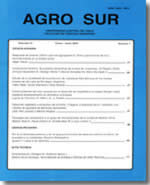COLLECTING AND MOLECULAR CHARACTERISATION MURTA (UGNl MOLINAE TURCZ.) GERMPLASM IN CHILE
Main Article Content
Abstract
One hundred accessions of murta (Ugni molinae Turez,} were collected during the 1996 season in an area extending from the VII to the X Región (35° to 42º SL). Sites of collection were characterised by marine climatic and soils with low levels of N and available P, low levels of exchangeable K and high levels of Al saturation. Fruits shown an extensive variability ín chemical and physical properties with both size and weight decreasing from North to South and soluble solids increasing . A clear relationship between euvironmental conditions and the expression of fruit colour was found, with pink and yellow fruits being more frequent towards the North whereas red fruits were common towards the coldest southern area. Variability within the population was confirmed at molecular level by applyíng the random amplified polymorphic DNA (RAPD) technique. By using 31 polymorphic loci generated by seven primer, similarities among accessions ranged from 0.100 a 0.833 and from 0.182 to 0.909 when Jaccard's and Nei and Li's coefficient of similarity where computed. These results show and extensive genetic variation within the population of Ugni molinae T. evaluated, and suggest the feasibility to irnprove commercial attributes of this species by single plant selection.

